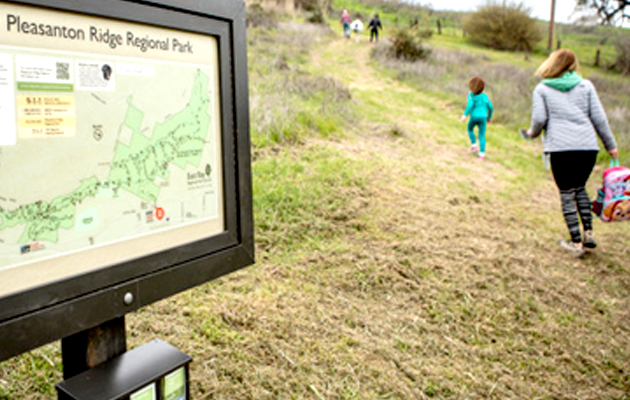
Millions of people who fled the confines of their homes during the height of the pandemic found peace, comfort and freedom in nature. Nature in all its glory will always welcome visitors, with one major provision. Kindness and respect, please.
The East Bay Regional Park District (EBRPD) saw a 400 per cent increase in visitation at its 73 parks spanning 125,00 acres in 2020 and 2021. While this has been instrumental to the health and well-being of over 30 million (and growing) guests, the astronomical increase in attendance brings ongoing risks to the delicate habitats, eco-systems and wildlife that live there.
“Usage of the park has changed over the decades,” says Dee Rosario, the first Filipino and Asian American board member with EBRPD. “People used to seek solace and solitary isolation back in the 70’s but now, with the Bay Area’s diversity, we see whole families coming with their own interpretation of what it means to enjoy nature.”
Rosario was one of a panel of park stewards who spoke at a media briefing co-hosted by EMS and EBRPD on ways for the surge of visitors to enjoy but not destroy public parks. He found his calling to nature once he laid eyes on his first majestic redwood tree in Humboldt County on a wrestling team road trip in ‘75. Thirty-seven years later, still with the park district, he’s committed to helping the public understand the history, enjoy and respect the local habitats and develop a caring consciousness of the impact human presence has on the land and animals.
“Once you care, you’ll take care,” says Becky Tuden, Environmental Services Manager with EBRPD. As a steward of the parks, she not only helps protect, serve and conserve the unique biodiversity of East Bay coastal lands, woodlands and grasslands, but aids in making them accessible and meaningful to the public for present and future generations.
Some parks were designed to be closer to dense neighborhoods, some are bigger and wilder and others are more recreational with picnic areas and swimming lagoons or interpretive centers where people gather. “We encourage people to come to the gateway parks where there’s turf and volleyball fields,” says Tuden, “with some animals and trees but not as much of a wildlife habitat.” She says when people enter wild lands, they take up time and space from the animals because they flee and are not able to feed or take care of their young, which can lead to loss of habitat and food.
Among the many stressors on the environment such as climate change, drought, fire danger and infrastructure, the impact of the influx of people is massive and awareness is critical. For example, Tuden and the stewardship see the effects of peoples’ beloved dogs that are off leash, trampling sensitive vegetation, menacing nesting birds and animals on lowlands and generally making parks unsafe. Also, increased litter is still an ever-present old-school problem.
Doug Bell, EBRPD Wildlife Program Manager cites three simple nature preservation principles. Enjoy, but don’t disturb. Hiking alone can intrude on wildlife but visitors are asked to read the signs and stay on the trails. Some may be closed because birds are nesting, or other wildlife may be at risk. One time a visitor’s drone crashed into a bald eagle’s nest. The scared parents fled, and the chicks likely did not survive.
Another important rule is to enjoy, but don’t feed, no matter how tempting. “A fed animal is a dead animal,” says Bell. “Feeding causes animals to forage in garbage cans or picnic areas with dire consequences.” Coyotes and raccoons can get aggressive once fed by humans and could bite a child or attack an adult and must be removed.
Releasing cats into the wild is strongly discouraged. “This increased over the pandemic with families not being able to care for their pets,” says Bell. It caused an overpopulation of feral cats that threatens endangered species like the plover (a rare shoreline bird) and the wood rat among other rare rodents native to the area. Shelters are the best places to take domestic felines.
Releasing is also a problem for the ten fishing reservoirs and four shoreline fishing piers managed by Joe Sullivan at EBRPD. “We want people to enjoy the great family activity of fishing but there are sensitive species in danger,” says Sullivan. Releasing goldfish and turtles from pet stores and markets that carry diseases and parasites can wipe out entire populations of species, some federally endangered such as the California red-legged frog, the tiger salamander, and native rainbow and steelhead trout. Please note, all endangered aquatics are in the streams and fishing is never allowed there.
“People sometimes release fish for ceremonial or religious reasons, and we welcome this but please do so responsibly,” says Sullivan. EBRPD stocks clean and disease-free fish in its reservoirs from licensed and accredited hatcheries, so these are recommended instead of fish store varieties. Also “realize that released animals of any kind will not last very long,” notes Sullivan. “It’s a hard life for a pet to make it in the wild.”
The stewardship at EBRPD is delighted that so many are embracing what is their life’s work and taking advantage of the assets of the incredible biodiverse lands accessible to all. But they remind everyone of their responsibility. Because their desire to be so close to nature, without conscious care and respect, can ultimately be responsible for destroying it.
